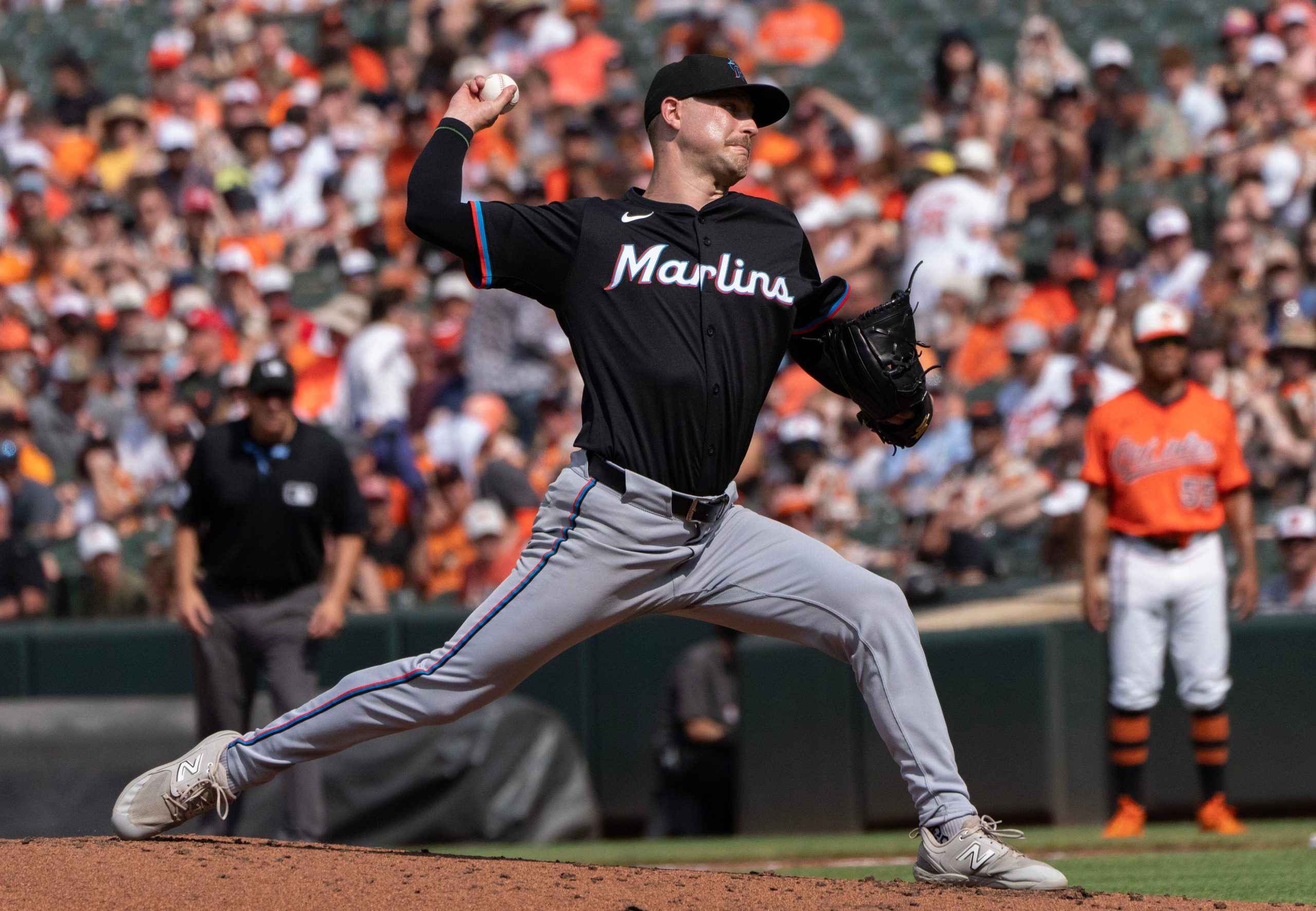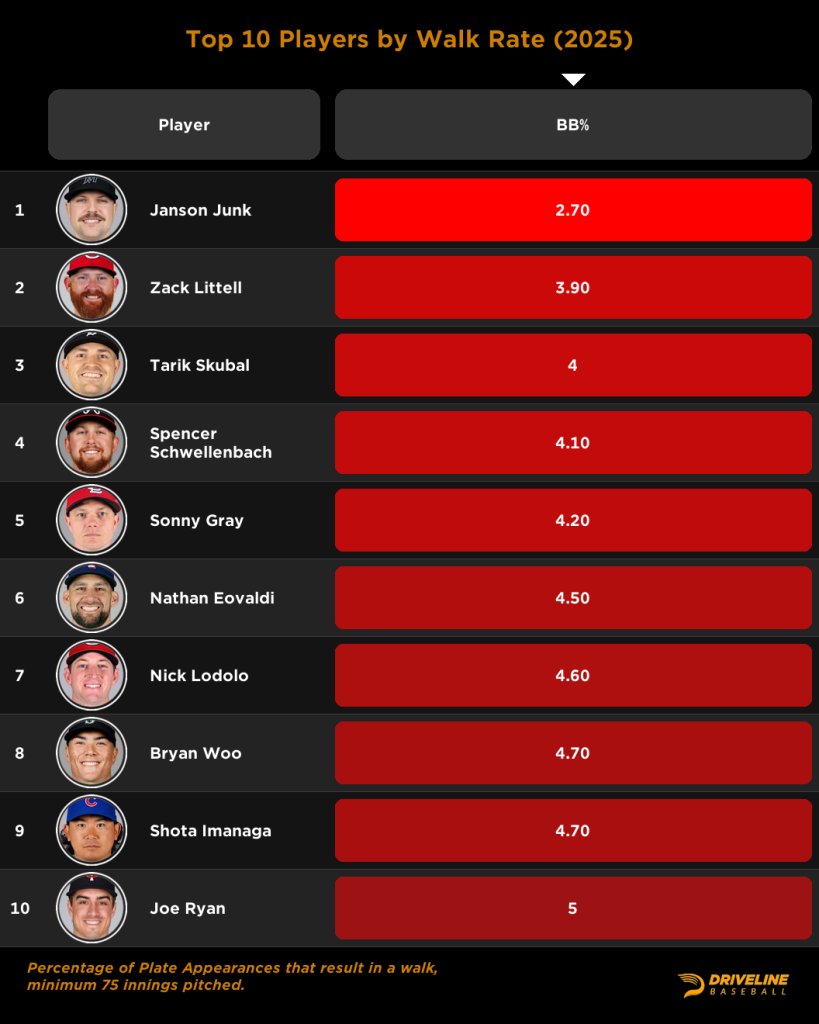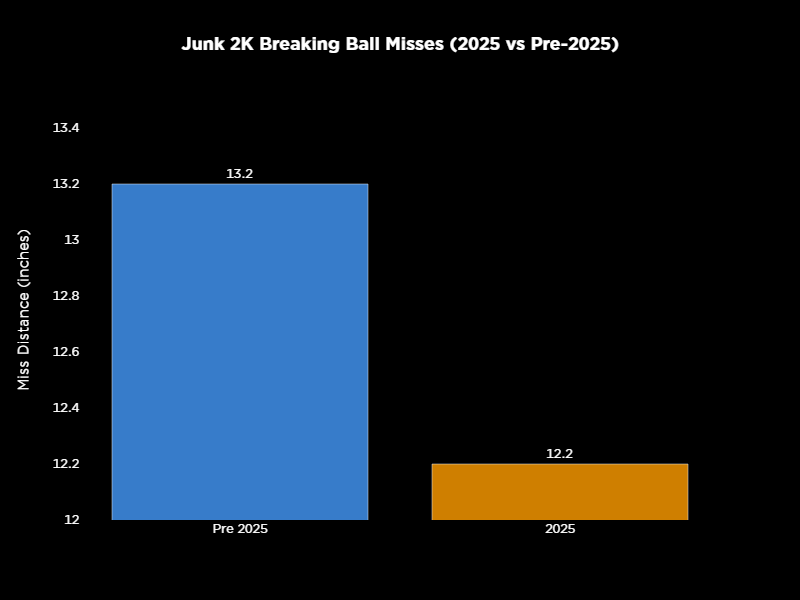How Intended Zones Helped Janson Junk and Stefan Raeth to Breakout Seasons

Janson Junk is a Driveline OG.
The Miami Marlins right-hander has evolved and grown along with the company. So, it makes sense he was something of a guinea pig this past winter.
Back in 2013, the Seattle-area native heard about a pitching guru in the area from his then high school teammate, Chris Carns. Carns’ select team trained at the same facility where Kyle Boddy was renting space. Junk soon began training with the Driveline founder.
By the time he was a high school senior, Junk’s fastball velocity had jumped into the low 90s. He landed an offer to pitch for Seattle University, and was drafted by the Yankees in the 22nd round of the 2017 draft. He kept beating the odds as he made his major league debut with the Angels in 2021.
Being the only Decatur High (Wa.) graduate to step on a major league field, Junk is already an outlier success story. But last offseason he wanted to make another jump.
Entering the winter, he had bounced around six different MLB organizations, logging 40 combined innings across parts of four seasons in the majors. He was entering his age 29 season. He knew he was running out of time to establish himself as a major leaguer.
As he did many off seasons, he returned to Driveline. He was always open to new technology and training. So, last winter he was open to experimenting with one of Driveline’s most important new tools – Intended Zones Tracker – and one of 2025’s most unlikely breakout stories followed.
While massive gains have been made in pitch design and velocity-building programs, improving command remained elusive.
And it was improving command that could most help Junk. He had good but not elite stuff.
He had no expectations of the new tool. He was mostly curious. But what followed was remarkable improvement.
“Early on, I was kind of just throwing to it without really any expectations of what I was going to get out of it. ‘OK, I will hop on and we can get some data,’’ Junk explained to me of his early offseason. “After doing it for a while, I think that is when I noticed I was hitting my spots more frequently. My focus on the target had more intent … “It was like this slow drip. I wasn’t looking for anything specific. It ended up helping me, realizing, ‘Oh crap. This is actually working.’”
Junk has cut his walk rate from 8.3% last season in the minors – the mark was also 8.3% in a brief major league stint – to 2.7% this year, the best rate among pitchers to throw at least 75 innings.

Tarik Skubal, a former Seattle U teammate, leads qualified pitchers with a 3.8% mark.
While Junk’s Stuff+ scores have remained constant this year, his walk rate and underlying Location+ scores vaulted into elite status.
He wasn’t expecting those results, that improvement, or how it changed what he thought he knew about locating a pitch.
Great progress in increasing velocity, in pitch design, came after we began measuring progress.
For velocity it was the radar gun. In pitch design it was the combination of high-speed cameras and spin-tracking tech that became a Rosetta Stone.
What was lacking in command training was an ability to quantify location quality and improvement in practice settings.
Enter the Intended Zones Tracker.
With the tool, a pitcher or coach uses a touch screen to move the visible crosshairs of their intended target, a digital catcher’s glove, on the interactive screen that is placed at home plate in a bullpen setting.
The location of the pitch, how close it was to its intended target, are automatically recorded in addition to the pitch’s spin, velocity, and expected run values.
“With anything, it starts with measuring it in a practice setting, the same way velocity started to explode as soon as we got reliable radar gun data,” Driveline’s Joel Condreay said. “Now we can measure these things. Same way as if I need to gain or lose weight, a great way to start is to step on a scale.”
This past winter, it was fitting that Junk, an early Driveline trainee, was one of the first to buy into the training tool.
“He was on the Intended Zones tool twice a week basically the whole winter,” Condreay said of Junk.
Junk had plenty of experience in the past with trying to hone his command by throwing to nine pockets, those contraptions where pitchers throw to a facsimile of a strike zone that is divided into nine sections of numbered targets.
But there was no tech recording his actual performance with a nine pocket, and there was no target like the Intended Zone’s glove to throw toward.
Initially he just started playing light toss with the IZ tracker but then Junk advanced to throwing all his higher-intent bullpens with the tool.
He noticed with Intended Zones he was more focused. He was practicing with more intent. Yes, it helped that there was a digital catcher’s glove making it more game-like. But he also knew his performance was being recorded. That feedback loop was just as critical as it was in, say, pitch design. He wasn’t guessing about progress, or a step back, it was there in black and white.
He also noticed he was getting better.

His average slider miss distance improved from 12.5 inches from 2021-24 data, to 10.8 this season.
“Understating your miss – the size of your miss and being able to work backward from there is key,” Junk said. “‘This is the arm path I need to take. This is what I need to do to hit this spot and get my average miss down.’ Things like that. Command is a tricky thing.”
But the Intended Zones Tracker makes training less murky.

He found the IZ tracker was particularly valuable for his breaking ball.
“My four-seam fastball is a straight pitch. That’s kind of easy for me. Just look at the intended target and throw it,” Junk said. “Whereas breaking stuff is kind of more ambiguous. You need to understand targets a little more, being able to execute at an efficient, high level – especially at the major league level … “If you want to have a two-strike slider, you need to miss down and away versus up out over the middle. If you don’t understand your miss, then more often than not you are going to leave that pitch middle, and it’s going to get hit.”
The tool informed Junk he had been doing something all wrong.
Before using Intended Zones, Junk, a righty, set his sights on the catcher’s left shoulder when throwing his breaking ball.
“I always thought that was the right thing to do but more often than not I would leave that pitch arm side, so that was kind of my miss with it,” Junk said. “I was like ‘Ugh, I swear I am doing everything right’ … But in reality, I was missing more arm side with that location.”
What he began to do was start the pitch more center.
“Your breaking ball is not going to move 24 inches from your initial target,” Junk explained. “If you throw it to that initial target, to the shoulder, it’s going to have to break 24 inches to be able to execute it. That was eye-opening.”
He changed his sights to be better able to locate down and away.

“Same thing for me with my curveball and my changeup,” he said. “My change is a seam-shifted, kick-change. For me to be able to execute it, I need to cut it glove side just a tad. I don’t want a down-and-away target to a lefty. I kinda want a more middle target …. and then it’s just going to come back and fade out. And then my curveball, it’s more of a 12-6 type curveball. So, it’s like ‘Alright, we are playing with visuals. This is your early breaking ball. This is your two-strike breaking ball. This is where you need to start it to have quality miss, or, to get in the zone.’
“I think the visual representations really help with the breaking stuff.”
While it’s limited major league sample of work, his breaking ball run value totaled –2 runs above average entering this season, compared to a +6 run value this season.
And his fastball location improved, too. His four-seamer missed by an average of 12 inches (2021-24) to 9.6 inches this season.
The change was not because of a dramatic improvement in the quality of its raw stuff, rather, because of where he located the pitch. His sweeper owns its lowest average height upon reaching the plate of his career, but it’s also further to his glove side when it reaches the plate.
“‘You are missing by this much. We can adjust that miss by your target sightline and maybe it will help you execute that pitch a little bit more,’” said Junk said of the advice he received from the Driveline staff.
Condreay also placed an MLB-style pitch clock on Junk so he would be executing with the pressure and tempo of the clock.
“‘You’re going to make a pitch every 25 seconds today’,” Condreay said he would tell Junk. “We are going to have a five-pitch burst of 23 second intervals, building that up through the offseason, and making sure they are prepared for whatever stressor they are going to be subjected to once they get into their season and report to their club.
“From an injury-risk standpoint, what we do is quite a bit lower risk than your average (approach). Because we are so particular with the way we subject guys to stress.”
The training worked wonders for Junk, who is now very much in the Marlins’ plans for 2026 and beyond. He’s accumulated 1.8 fWAR over 75 innings, and his 2.99 FIP that suggests he’s been even better than his 4.06 ERA.
Junk wasn’t the only pro pitcher to benefit.
Another remarkable 2025 breakout story tied to the Intended Zones is that of Stefan Raeth.
Raeth was already a success story when he advanced to pitch in High-A last season as a 17th-rounder in the 2022 draft, signing for $50,000 out of the University of Washington.
The Mariners’ farmhand trained at Driveline during previous offseasons, work which helped him to develop a sweeper that he says grades as a 120 Stuff+ offering, along with a plus cutter he had developed.
But he had a new goal last winter and that was improving his command.
While he’d improved his stuff and expanded his pitch arsenal, he was plagued by command woes.
So, after last season, he began using Intended Zones.
For Raeth, throwing with the tracker increased the intent and focus of his practice dramatically.
“Throwing to a nine-pocket can get very monotonous and very boring. A lot of athletes struggle with that,” Raeth said. “I was one of those, too. It’s just tough. It’s difficult to just continually throw to that.
“By forcing yourself to throw in such an uncomfortable environment, and getting feedback right away, that definitely helps.”
Raeth posted walk rates of 14.3%, 13% and 10% in his first three years of affiliated baseball.
This season, his fourth? 5.4%.
During his first bullpen session of the offseason pitching with Intended Zones he said his average miss distance on his sweeper was 17 inches. During his final bullpen of the winter, he said it was just shy of 10 inches. The average MLB pitcher misses location by about a foot.
“It decreased quite a bit over time,” Raeth said. “You’re seeing better real-time live results and it’s just quicker. You are able to identify that you are missing, and you are able to target this better. It helps you establish everything and makes you a better pitcher overall. I’ve definitely seen the benefit of using it.”
Does Raeth have any other secrets in explaining his jump from a 3.77 ERA and 8.5% k-BB% mark in High-A last year to a 2.06 ERA and 25 K-BB% this year? The performance earned him a recent promotion to Double-A.
“Grunting,” he said.
Raeth was sitting with a teammate on his apartment couch this spring when his buddy suggested he grunt like he did at pitch release. Raeth did it during his next outing and struck out the side.
“Committing to every pitch,” he said, “saying ‘Screw it,’ and just going for it.”
Grunting plus Intended Zones? It could be a winning combination.
Comment section